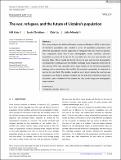Files in this item
The war, refugees, and the future of Ukraine's population
Item metadata
| dc.contributor.author | Kulu, Hill | |
| dc.contributor.author | Christison, Sarah | |
| dc.contributor.author | Liu, Chia | |
| dc.contributor.author | Mikolai, Julia | |
| dc.date.accessioned | 2023-03-30T14:30:03Z | |
| dc.date.available | 2023-03-30T14:30:03Z | |
| dc.date.issued | 2023-05-02 | |
| dc.identifier | 283823934 | |
| dc.identifier | ce9b7277-4d79-4ef0-887f-5169790993fb | |
| dc.identifier | 85151985038 | |
| dc.identifier.citation | Kulu , H , Christison , S , Liu , C & Mikolai , J 2023 , ' The war, refugees, and the future of Ukraine's population ' , Population, Space and Place , vol. 29 , no. 4 , e2656 . https://doi.org/10.1002/psp.2656 | en |
| dc.identifier.issn | 1544-8444 | |
| dc.identifier.other | ORCID: /0000-0002-7733-6659/work/132214027 | |
| dc.identifier.other | ORCID: /0000-0001-8808-0719/work/132214085 | |
| dc.identifier.uri | https://hdl.handle.net/10023/27301 | |
| dc.description | Funding: This paper is part of a project that has received funding from the European Research Council (ERC) under the European Union's Horizon 2020 research and innovation programme (Grant Agreement No. 834103). This research was also supported by the Economic and Social Research Council Centre for Population Change Connecting Generations research programme, grant number ES/W002116/1. | en |
| dc.description.abstract | This study analyses the effect of Russia's invasion of Ukraine in 2022 on the future of Ukraine's population. We conduct a series of population projections with different assumptions on the proportion of refugees that may return to Ukraine. Our projections show that if past demographic trends continue, Ukraine's population is projected to decline by one-sixth over the next two decades and become older. These trends are largely driven by past and current demographic developments: continued very low fertility and large-scale emigration at the turn of the century. With war casualties and a large portion of the Ukrainian population seeking safety abroad from the conflict, the country's population is projected to decline by one-third. The decline would be even larger among the working-age population and children. Russia's invasion has not only led to immense human and economic costs in Ukraine in the present but also carries long-term demographic repercussions. | |
| dc.format.extent | 13 | |
| dc.format.extent | 2240450 | |
| dc.language.iso | eng | |
| dc.relation.ispartof | Population, Space and Place | en |
| dc.subject | Demography | en |
| dc.subject | Refugees | en |
| dc.subject | Ukraine | en |
| dc.subject | War | en |
| dc.subject | GF Human ecology. Anthropogeography | en |
| dc.subject | 3rd-DAS | en |
| dc.subject | SDG 10 - Reduced Inequalities | en |
| dc.subject | SDG 16 - Peace, Justice and Strong Institutions | en |
| dc.subject | MCC | en |
| dc.subject.lcc | GF | en |
| dc.title | The war, refugees, and the future of Ukraine's population | en |
| dc.type | Journal article | en |
| dc.contributor.sponsor | European Research Council | en |
| dc.contributor.institution | University of St Andrews. Population and Health Research | en |
| dc.contributor.institution | University of St Andrews. Sir James Mackenzie Institute for Early Diagnosis | en |
| dc.contributor.institution | University of St Andrews. School of Geography & Sustainable Development | en |
| dc.contributor.institution | University of St Andrews. Geographies of Sustainability, Society, Inequalities and Possibilities | en |
| dc.identifier.doi | 10.1002/psp.2656 | |
| dc.description.status | Peer reviewed | en |
| dc.identifier.grantnumber | 834103 | en |
This item appears in the following Collection(s)
Items in the St Andrews Research Repository are protected by copyright, with all rights reserved, unless otherwise indicated.

